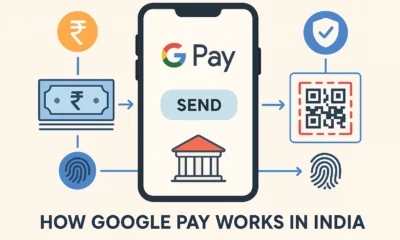Technology
How to Spot Fake News Online: 10 Simple Tips to Stay Safe

Spot Fake News: In today’s rapidly growing digital world, we are surrounded by information. Social media, news sites, blogs, YouTube videos, WhatsApp ahead – we are going everywhere, and something new is shared. But here’s the problem: all this is not true. Some of these are fake news, and it spreads like a fire.
Fake news can mislead people, create fear, damage reputations, and even affect major decisions such as choices or health alternatives. This is why it is more important to learn how to spot fake news online and be safe. Good news? This is not difficult to do-you just have to know what to see.
What is Fake News?

Fake news is false or misleading information shared with the intention of confusing, cheating, or manipulating people. It is often designed to look real, use attractive headlines, secure images, or use emotional language, but it is not based on confirmed facts or reliable sources. Some fake news is designed to use sensational or fantastic material to attract pure clicks and generate advertising revenue.
Why is Fake News Dangerous?
False news may seem harmless at first, but it can cause real problems that affect individuals, communities, and even entire countries. This is how fake news can damage:
- Spread fear or nervousness:
Fake news often uses scary headlines or fake claims to make confusion. It can worry people, cause panic in an emergency, or make them work without thinking clearly. - Damage to someone’s reputation:
False stories or edited images can seriously damage one’s personal or business. Although the truth comes out later, the loss often occurs already. - Mislead people during elections:
During the election, fake news can be used to spread lies or rumors about candidates and political parties. This can affect how people vote and produce unfair results. - Encourage harmful behavior:
Fake health tips, dangerous challenges, or wrong advice can motivate people to make decisions. Believing such news can lead to health and safety risks. - Distracted by real problems:
While people are busy discussing fake stories, important topics such as education, health care, or the environment can be ignored or forgotten.
10 Simple Tips to Stay Smart and Safe
1. Check the Source
Before you trust or share news, you can always look at the source.
- Is the website or platform well-known?
- Is it a trusted news outlet like BBC, NDTV, India Today, or Reuters?
- Or is it an unknown blog, a WhatsApp message or a random Facebook page?
Fake news often comes from websites with weird names filled with “BreakingNewsdailyz.com” or many ads. This is red flag.
Pro Tip: Always verify the credibility of the website before trusting the content.
2. Read the Full Article — Not Just the Headline
Headlines are often designed to grab your attention. Some may even be clickbait, meaning they are meant to attract clicks, not inform you.
- A shocking or emotional title cannot reflect the whole story.
- Many fake news makers use half of the truth or exaggeration in the title of miscarriacers.
Always take a moment to read the entire article before reacting or sharing.
Example: A headline says “Cure for Cancer Found!” but the article talks about an experiment done only on mice — that’s misleading.
3. Look at the Author
Who wrote the article?
- Reputable news has real journalists and named authors.
- False news articles often have no business or use common names such as “admin”, “editor” or “Staff author”.
- Sometimes fake news sites also create fake identity to look even more valid.
If a writer is mentioned, Google for them. Do they have other articles? Are they on LinkedIn or other professional platforms?
Fact Check: If the author is unknown or doesn’t exist, don’t trust the content blindly.
4. Cross-Check With Other Sources
One of the easiest ways to verify news is to see if other trustworthy sources are reporting the same story.
- If something really happened, chances are multiple news outlets are covering it.
- If only one shady website is reporting something big, it’s likely false or exaggerated.
Use Google News to search the topic and compare reports.
Real news is usually covered by many outlets, not just one.
5. Check the Date and Timeline
Old news sometimes becomes viral, especially in similar situations.
- Always check for the published date of the article.
- Some fake news posts reuse past stories to create panic in the present.
Also, check if the timeline of events makes sense. A post claiming an event happened “yesterday” might actually be from 5 years ago.
Outdated information can be just as misleading as fake news.
6. Analyze the Tone and Language
Fake news often uses:
- Extreme emotional language (fear, anger, jerk)
- Excessive capital paper and wonderful brand
- Many spelling and grammar errors
This is done to trigger rapid reactions without thinking of people.
Always stay calm and think before reacting emotionally to a news piece.
7. Examine the Images and Videos
Fake news often uses medical images, edited videos, or media that out of context.
- A photo from one country’s protest may be shown as another country’s issue.
- Videos may be cropped or taken from old incidents.
Use Google’s reverse image search or Tineye to use an image.
Don’t trust everything you see — visuals can be easily manipulated.
8. Use Fact-Checking Websites
Many organizations are dedicated to fact-checking viral news. Before you share something doubtful, check these platforms:
- Alt News – Popular in India
- Boom Live
- Factly
- Snopes – Global
- PIB Fact Check – Government of India initiative
Just type the headline or keywords and search on these sites. You’ll find out quickly if it’s fake.
Let fact-checkers do the hard work — use them!
9. Avoid Blindly Sharing WhatsApp Forwards
Some of the most viral fake news comes through WhatsApp and Telegram groups.
- The message that states that “many times ahead” should be taken with care.
- Don’t think the news as it comes from a family group or friend.
- Check the info using Google or a fact-check site before sharing.
If it sounds too good or too scary to be true — it probably is.
10. Trust Your Instincts and Think Critically
Sometimes, your common sense is the best tool.
- Does the story sound believable?
- Is there real evidence or is it all opinions?
- Why is this being shared? Who benefits?
Ask yourself these simple questions. If something feels off, it usually is.
Be skeptical — not everything online is true, and that’s okay.
Frequently Asked Questions (FAQs)
How can I quickly check if news is fake?
Why do people create fake news?
Is fake news a crime in India?
What apps can help detect fake news?
-

 Automobile6 months ago
Automobile6 months ago5 Best Bikes Owned by Bollywood Stars
-

 News6 months ago
News6 months agoNirmal Kapoor, Anil Kapoor’s Mother, Passes Away at 90
-

 Lifestyle5 months ago
Lifestyle5 months agoMedha Shankar Age, Movies, and TV Shows – Full Biography of a Rising Star
-

 Technology5 months ago
Technology5 months agoBest Free Apps You Should Try
-

 Technology6 months ago
Technology6 months ago7 Industries Benefiting from Deep Learning Algorithms
-

 Technology1 month ago
Technology1 month agoWhat is Metaverse? Simple Explanation for Beginners
-

 Technology1 week ago
Technology1 week agoHow to Use Google Pay Safely in India – Complete Beginner’s Guide
-

 Lifestyle3 days ago
Lifestyle3 days agoBest Free Learning Websites for Students

